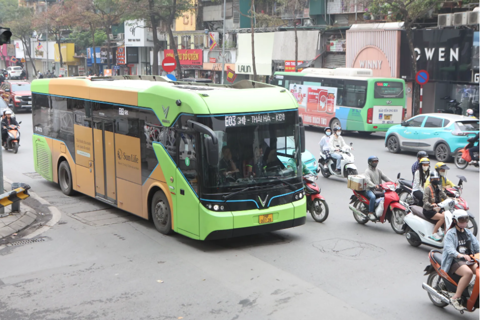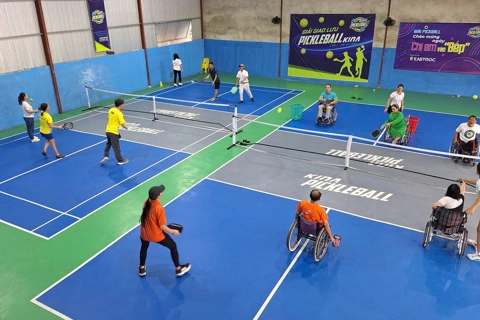Hanoi
Public Transport as Guide for Urban Development
Jun 28, 2017 / 05:29 PM
Experts agreed that the Hanoi public transportation network has received heavy investment, but the network is still fragmented and lacks focus, unable to fulfill its role as guiding the urban development.
They also said that if public transport problem failed to be solved, the City is likely to lose the chance of becoming a modern, sustainable and smart city.
Low efficiency
According to the investigation by the Vietnam Institute for Development Strategy, 80.19% of Hanoi citizens rarely or never use bus for commuting. This fact is explained by the fact that there are 5 million motorcycles and 500.000 cars in a city of 7.5 million people. Obviously, as citizens prefer using private vehicles, the public transport is left aside. The increase in the use of private vehicles is explained by the insufficient bus service, the bus network is unable to cover every points of the city, the lack of connectivity among bus lines, the lack of bus lanes, among other reasons.
As an example put forth by he senior transport specialist of the World Bank in Vietnam, Dr. Jen Jung Eun Oh who said that Seoul has 8 bus lines only with approximately 50 buses running at night. However, the transportation system still meets the need of about 50% of the demands at night of a gigantic urban area. It is not the bus network coverage or the number of public transport vehicles decisive but working out suitable bus routes is more important in improving the efficiency of public transport.
Dr. Jen Jung Eun Oh added that , in a city with the most modern public transport system, people still have to walk from homes to bus or metro stations. If they choose to walk to public transport stations instead of using personal cars or motorcycles, the the public transport system is considered successful.
According to expert Dinh Quoc Thai from the Department of Planning and Architecture, Hanoians are living along the roads. The roads are narrower downtown, unsuitable for public transport. Private vehicles, especially motorcycles in particular, are still the top choice for the majority of people. That’s why they oppose to the city plan of fasing out two-wheelers step by step in Hanoi’s downtown by the year 2030. Architect Nguyen Van Dung raised the question: “Motorcycles are the daily means of transportation of the low income people. Given the insufficient number of buses; sky trains and metro systems still unfinished. How do the people commute if two wheelers are banned?”.
Neecessity of planning
Dr. Jen Jung Eun Oh agreed that the decision to ban motorcycles given the current situation is not an overall solution. Other experts suggest Hanoi to act drastically to distribute the people’s movement directions in an equal manner. One of the solutions is the relocation of hospitals, schools and factories out of the city’s downtown. Moving out these infrastructure of large people concentration will relax the pressure to the core of the city.
Besides, according to Dr. Jen Jung Eun Oh, Hanoi’s road network is expanded in service of four-wheelers movement. The space for pedestrians, bus lanes and parking area in connection with public transport are still lacking. Over the recent times, Hanoi has focused on the expansion of the public transport network and increasing the number of vehicles instead of creating easy access to public transport.
In general, the inconsistency between public transport development and urbanzation has posed a lot of challenges. Without any solutions to bring public transportation back to its role as the guide for urban development, Hanoi will proceed gradually to a congestion disaster
Focusing on critical matters
Nguyen Ngoc Quang, a transport expert, says that the concentration of jobs and socio-economic activities in Hanoi is mainly happening in the city center. Apartment building projects are thus located downtown, making it meaningless to expand public transport routes or roads in the effort to reduce congestion. Associate Professor Pham Thuy Loan, the Vice Director of the Vietnam Institute of Architecture, proposed the application of TOD (Transit Oriented Development) model for Hanoi. TOD means using the development of the transport system as a foundation for urban planning. People concentrations will be built around the transit hubs. In other words, the City needs to determine areas of high convenience for public transport to develop housing projects. Only then the public transport system is optimized.
Dr. Jen Jung Eun Oh shares that Seoul has applied successfully the model of TOD. Using the positioning system, the administration calculates the traffic flow to each area. Based on the calculating result and the evaluations of infrastructure, the public transportation network will be built accordingly. At the same time, the socio-economic centers will be established in those areas. In parallel with the strong investment in public transport, the City will enhance the development of shopping malls along the public transport lines . Once transit hubs or bus stops are connected to shopping malls, people will naturally choose public transport for commuting.
Low efficiency
According to the investigation by the Vietnam Institute for Development Strategy, 80.19% of Hanoi citizens rarely or never use bus for commuting. This fact is explained by the fact that there are 5 million motorcycles and 500.000 cars in a city of 7.5 million people. Obviously, as citizens prefer using private vehicles, the public transport is left aside. The increase in the use of private vehicles is explained by the insufficient bus service, the bus network is unable to cover every points of the city, the lack of connectivity among bus lines, the lack of bus lanes, among other reasons.
As an example put forth by he senior transport specialist of the World Bank in Vietnam, Dr. Jen Jung Eun Oh who said that Seoul has 8 bus lines only with approximately 50 buses running at night. However, the transportation system still meets the need of about 50% of the demands at night of a gigantic urban area. It is not the bus network coverage or the number of public transport vehicles decisive but working out suitable bus routes is more important in improving the efficiency of public transport.
Dr. Jen Jung Eun Oh added that , in a city with the most modern public transport system, people still have to walk from homes to bus or metro stations. If they choose to walk to public transport stations instead of using personal cars or motorcycles, the the public transport system is considered successful.

Bus of Rapid Transit network improves the public transport efficiency in Hanoi
|
Neecessity of planning
Dr. Jen Jung Eun Oh agreed that the decision to ban motorcycles given the current situation is not an overall solution. Other experts suggest Hanoi to act drastically to distribute the people’s movement directions in an equal manner. One of the solutions is the relocation of hospitals, schools and factories out of the city’s downtown. Moving out these infrastructure of large people concentration will relax the pressure to the core of the city.
Besides, according to Dr. Jen Jung Eun Oh, Hanoi’s road network is expanded in service of four-wheelers movement. The space for pedestrians, bus lanes and parking area in connection with public transport are still lacking. Over the recent times, Hanoi has focused on the expansion of the public transport network and increasing the number of vehicles instead of creating easy access to public transport.
In general, the inconsistency between public transport development and urbanzation has posed a lot of challenges. Without any solutions to bring public transportation back to its role as the guide for urban development, Hanoi will proceed gradually to a congestion disaster
Focusing on critical matters
Nguyen Ngoc Quang, a transport expert, says that the concentration of jobs and socio-economic activities in Hanoi is mainly happening in the city center. Apartment building projects are thus located downtown, making it meaningless to expand public transport routes or roads in the effort to reduce congestion. Associate Professor Pham Thuy Loan, the Vice Director of the Vietnam Institute of Architecture, proposed the application of TOD (Transit Oriented Development) model for Hanoi. TOD means using the development of the transport system as a foundation for urban planning. People concentrations will be built around the transit hubs. In other words, the City needs to determine areas of high convenience for public transport to develop housing projects. Only then the public transport system is optimized.
Dr. Jen Jung Eun Oh shares that Seoul has applied successfully the model of TOD. Using the positioning system, the administration calculates the traffic flow to each area. Based on the calculating result and the evaluations of infrastructure, the public transportation network will be built accordingly. At the same time, the socio-economic centers will be established in those areas. In parallel with the strong investment in public transport, the City will enhance the development of shopping malls along the public transport lines . Once transit hubs or bus stops are connected to shopping malls, people will naturally choose public transport for commuting.








